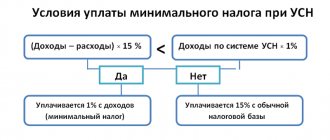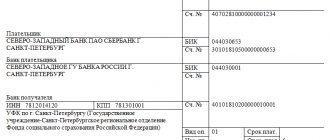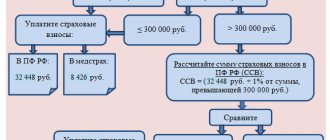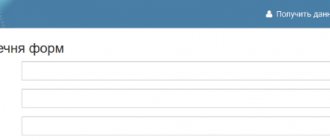Individual entrepreneurs and organizations that are employers are required to transfer insurance contributions (from employee payments under employment contracts). Monthly insurance premiums of individual entrepreneurs are transferred to:
- to the Federal Tax Service (for compulsory pension insurance);
- to the Federal Tax Service (for compulsory health insurance);
- to the Federal Tax Service (for insurance for temporary disability and in connection with maternity);
- in the Social Insurance Fund (for compulsory social insurance against accidents at work and against occupational diseases, in short, insurance against injuries).
In our publication today, we will find out the amount of individual entrepreneur contributions for employees in 2021 for transfer to the funds, as well as what kind of reporting individual entrepreneurs submit to these funds.
Note that from payments to individuals. to persons (on the basis of civil contracts), entrepreneurs must transfer contributions only to the Pension Fund and the Federal Compulsory Compulsory Medical Insurance Fund. Contributions are transferred to the Social Insurance Fund provided that this clause is provided for in the individual entrepreneur’s agreement with the employee.
Please note that in accordance with current legislation, some payments to employees are exempt from paying insurance premiums (Article 217 of the Tax Code of the Russian Federation).
Mandatory for all individual entrepreneurs is:
- registration with the Social Insurance Fund as an employer;
- In addition to contributions for employees, pay insurance premiums “for yourself.”
When is an individual entrepreneur obliged to pay insurance premiums?
Mandatory insurance premiums for individual entrepreneurs are payments that an entrepreneur must pay in almost any case. Even if the individual entrepreneur has no income.
Some exceptions are provided for periods when the individual entrepreneur does not operate due to certain reasons. For example, a parent individual entrepreneur takes care of a child under 1.5 years old, a female individual entrepreneur moved to another area with her military spouse and was forced to leave the business, etc.
However, in order to exempt an individual entrepreneur from paying insurance premiums for himself, each situation must be considered individually. It is necessary to fulfill 2 conditions:
- the situation of individual entrepreneurs is specifically formulated in the Tax Code of the Russian Federation;
- An individual entrepreneur can document the lack of income for the period for which he is asking for exemption (for example, in addition to a zero declaration, he can present the Federal Tax Service with bank statements where there is no movement of funds; documents on a change of place of residence; on termination of the lease agreement for the premises in which he was operating business, etc.).
In general, individual entrepreneurs’ insurance premiums for themselves in 2021 (the same as before) must be paid from the date of registration of the individual entrepreneur until the official termination of business activities.
What insurance premiums an individual entrepreneur pays depends on how he works - alone or with employees. Therefore, there are 2 types of individual entrepreneur insurance premiums:
- For myself.
- For those people who work for him.
If an individual entrepreneur has insurance premiums for employees or contributions under GPC agreements, he is required to submit reports on contributions and personalized accounting information.
Under civil law (GPC, GPD), the payment of insurance premiums by the individual entrepreneur for the performers depends on the subject of the contract.
| SUBJECT OF THE AGREEMENT | TAXATION OF GPA PAYMENTS WITH CONTRIBUTIONS |
| Performance of work, provision of services | Subject to contributions to the Pension Fund and the Compulsory Medical Insurance Fund in any case. Subject to contributions to the Social Insurance Fund for insurance against accidents and occupational diseases, if such a condition is included in the contract (for example, according to the GPA, work associated with increased danger is performed). |
| Copyright royalties and remunerations for rights to the results of intellectual activity | Subject to contributions to the Pension Fund and the Compulsory Medical Insurance Fund. When calculating the taxable amount, you can deduct the author's confirmed expenses for creating a work (the result of intellectual activity). |
| Transfer of ownership or temporary use of property (including lease agreements, donations) | Not taxed |
Due to the fact that the calculation and payment of insurance premiums for employees and individuals under the GPA is a separate large topic, later in this article we mainly consider the contributions of individual entrepreneurs for themselves.
Standard rates
The basic rates of insurance contributions are prescribed in Article 425 of the Tax Code of the Russian Federation. They are:
- pension insurance – 22% until the maximum base is reached, then – 10%;
- health insurance contributions – 5.1% regardless of the amount;
- contributions in case of illness or maternity - 2.9% until the maximum base value is reached, no further accrual.
An employee of a large organization Smirnov A.A. receives 180,000 rubles monthly. Let's consider how to calculate how many contributions the employer will pay for him in the first half of 2021, provided that no other payments were made to the employee. We will consider insurance premiums for 6 months as a cumulative total from the beginning of the year.
The maximum base for pension contributions in the first half of the year has not been exceeded (180,000 * 6 < 1,292,000), so a 22% tariff will be applied. The same amount will be paid each month, since the conditions do not change. In just six months, the employer will transfer: 180,000 * 6 * 22% = 237,600 rubles.
Medical contributions for each month are calculated at a rate of 5.1%. In just six months, the employer will pay medical contributions for employee Smirnov: 180,000 * 6 * 5.1% = 55,080 rubles.
When calculating insurance premiums for 6 months for disability, we take into account that the base will be 180,000 * 6 = 1,080,000 rubles, while its maximum value is 912,000 rubles. Therefore, we will accrue social contributions on an accrual basis only within this limit: 912,000 * 2.9% = 26,448 rubles.
The total amount of contributions for employee Smirnov for the first half of 2021 will be: 237,600 + 55,080 + 26,448 = 319,128 rubles.
Reduced rates for insurance premiums in 2021
| Payer category | Pension Fund | FFOMS | FSS | Total |
| SMEs with payments above the minimum wage | 10% | 5% | — | 15% |
| NPOs on the simplified tax system, conducting activities in the field of social services. services, science, education, healthcare, sports, culture and art | 20% | — | — | 20% |
| Charitable organizations on the simplified tax system | ||||
| Companies and individual entrepreneurs operating in the free economic zone in Crimea and Sevastopol, in the territories of rapid socio-economic development, in the free port of Vladivostok and in the special economic zone in the Kaliningrad region | 6% | 0,1% | 1,5% | 7,6% |
| Organizations that have received the status of a participant in the Skolkovo project | 14% | — | — | 14% |
| Organizations and individual entrepreneurs making payments to crew members of ships registered in the Russian International Register of Ships | — | — | — | 0% |
| Companies and individual entrepreneurs engaged in the production and sale of animated audiovisual products produced by them and (or) provision of services for the creation of such products | 8% | 4% | 2% | 14% |
| Organizations in the field of IT, design and development of electronic component base products and electronic (radio-electronic) products (provided that the income from this activity at the end of 9 months is at least 90%, and the number of employees is at least 7 people | 6% | 0,1% | 1,5% | 7,6% |
Note
: If the limits are exceeded, beneficiaries do not need to transfer contributions to social and pension insurance.
Additional rates for insurance premiums in 2021
| Payer category | Pension Fund | FFOMS | FSS | Total |
| Payers specified in paragraphs. 1 clause 1 art. 419 of Law No. 400-FZ in relation to payments to individuals named in paragraph 1 of paragraph 1 of Art. 30 of this law | 9%* | — | — | 9% |
| Payers specified in paragraphs. 1 clause 1 art. 419 of Law No. 400-FZ in relation to payments to individuals named in paragraphs 2-18 of paragraph 1 of Art. 30 of this law | 6%* | — | — | 6% |
*After a special assessment of working conditions, depending on its results, the rate of additional insurance premiums will be from 0 to 8% (details in clause 3 of Article 428 of the Tax Code of the Russian Federation).
Note
: Additional contributions are paid regardless of limits.
Insurance contributions from the salary of a disabled employee
Until 2015, preferential tariffs were applied for calculating contributions from the remuneration of employees who are disabled people of groups I-III. With the repeal of Law No. 212-FZ from 01/01/2015, preferential tariffs no longer apply.
Moreover, this rule applies to all categories of employers: both for ordinary organizations and individual entrepreneurs, and for public organizations.
Consequently, employers employing disabled people pay insurance contributions to the Federal Tax Service at standard rates.
The situation is different with payments for injuries. If the payer employs disabled people of groups I-III, then contributions for them are paid in the amount of 60% of the established tariff.
Insurance premiums from the salary of a deceased employee
When calculating earnings and compensation for unused vacation for a deceased employee and issuing such amounts to members of his family, insurance premiums do not need to be withheld.
In accordance with paragraph 1 of Art. 420 of the Tax Code of the Russian Federation, the object of taxation of contributions for employers is payments made to insured individuals. Considering that there is no insured individual in this situation, there is no obligation to charge contributions.
Insurance premiums from gifts to employees (children of employees)
The obligation to accrue contributions for a gift to an employee may arise depending on the purpose of issuing such a gift:
- if a present is given to an employee as a reward for work, then its value will be considered a bonus, i.e., part of the remuneration. Since payments within the framework of an employment relationship are considered subject to contribution, the employer should calculate and transfer insurance payments from the value of such a gift;
- if the gift is not related to the employee’s work activity, but is given for a holiday (birthday, anniversary, etc.), and such payment is not reflected in the labor or collective agreement, then the object of taxation of contributions does not arise.
To avoid questions from regulatory authorities, the issuance of a gift should be documented in a gift agreement. At the same time, the content of the contract should not contain any mention of labor regulations, and the value of the gift should not be tied to the employee’s salary or other indicators of work activity.
If an employer gives gifts to the children of employees for the New Year, the following options are possible:
- the cost of the children's gift is paid to the employee in person - insurance premiums should be calculated and paid in the general manner;
- children's gifts were purchased by the employer independently - there is no object for taxation of contributions, since the children of employees cannot be in an employment relationship with the payer and, accordingly, are not insured persons.
Insurance premiums for excess daily allowance
From 2021, payers are required to charge insurance premiums for compulsory health insurance, compulsory medical insurance and compulsory health insurance for daily allowances in excess of established limits (clause 2 of Article 422 of the Tax Code of the Russian Federation), i.e. for daily allowance amounts exceeding:
- 700 rub. – during business trips within the country;
- 2,500 rub. – on foreign business trips.
At the same time, contributions for injuries, regulated by the law of July 24, 1998 No. 125-FZ, are not charged on daily allowances, regardless of their size (within or above the limit).
How to calculate insurance premiums for individual entrepreneurs for yourself
Individual entrepreneurs’ insurance premiums for themselves contain 2 components:
Fixed insurance premiums for individual entrepreneurs for themselves in 2021
Fixed contributions for 2021 for individual entrepreneurs are set at:
- for compulsory pension insurance (OPS) – 32,448 rubles ;
- for compulsory medical insurance (CHI) – 8426 rubles .
Note that these are amounts for the full year. However, if for some reason the individual entrepreneur did not work for all 12 months or part of the year fell during the period when the individual entrepreneur was exempt from paying contributions, the annual amount should be recalculated.
The calculation is based on the proportion between the number of months and days in a full year and the number of months and days during which there was an obligation to pay contributions.
ADVICE
In order not to waste time on calculations and not to increase the risk of error , we recommend that individual entrepreneurs without much experience in tax calculations use the official Individual Entrepreneur Insurance Premium Calculator on the website of the Federal Tax Service of Russia. As a bonus, when you receive the calculation results, the current BCCs will be indicated where each amount should be paid.
Insurance premiums of individual entrepreneurs for themselves - 1% of excess
Excess contributions are sometimes called additional contributions. They are calculated using a simple formula:
ADDITIONAL CONTRIBUTIONS = (Individual entrepreneur’s income for the year – 300,000 rubles) × 1% |
If the income is less than 300,000 rubles, then additional contributions are considered equal to zero . And the individual entrepreneur must pay only fixed amounts for the year.
The main nuance that an individual entrepreneur needs to understand is determining what exactly to put in the formula as income . Under different taxation regimes, income for individual entrepreneurs' insurance premiums differs.
Important
Until 2021, the question of calculating income for additional contributions on the “income-expenditure” simplified tax system was open: tax authorities demanded that it be calculated without taking into account expenses. But a Constitutional Court decision in 2021 made such demands illegal.
We talked about this in more detail in the article “How to calculate 1% of contributions from excess income for an individual entrepreneur on the simplified tax system for 2020.”
This might also be useful:
- Fixed payments for individual entrepreneurs in 2021 for themselves
- Changes in individual entrepreneur taxation in 2021
- What taxes does the individual entrepreneur pay?
- What reporting must an individual entrepreneur submit?
- How much taxes does an individual entrepreneur pay in 2021?
- The amount of insurance premiums for compulsory health insurance and compulsory medical insurance for individual entrepreneurs in 2021
Is the information useful? Tell your friends and colleagues
Dear readers! The materials on the TBis.ru website are devoted to typical ways to resolve tax and legal issues, but each case is unique.
If you want to find out how to solve your specific issue, please contact the online consultant form. It's fast and free!
The procedure for paying insurance premiums for individual entrepreneurs for themselves
Individual entrepreneurs often ask the question whether there is any schedule for paying insurance premiums for individual entrepreneurs for themselves. For example, quarterly.
We answer: the deadlines for paying insurance premiums for individual entrepreneurs on a quarterly basis have not been established . Fixed contributions can be paid at any time during the year. The main thing is not to miss the deadline - December 31st . Additional contributions also be paid in one payment on any date in the first half of the year following the billing year.
individual entrepreneur can draw up a schedule for the payment of insurance premiums for himself on a quarterly basis in order to reduce taxes payable. For example, quarterly advances according to the simplified tax system. We'll talk more about the principles of this reduction later.
When should insurance premiums be paid to an individual entrepreneur if he decides to end his entrepreneurial activity? In this situation, individual entrepreneur contributions must be paid no later than 15 calendar days from the date the individual entrepreneur is deregistered with the Federal Tax Service.
Contributions for employees to the Federal Tax Service: tariffs
As for the tariffs at which employers transfer contributions for employees to the Federal Tax Service, they can be classified into 3 types:
1. Standard.
2. Preferential:
- with reduced rates;
- with partial application of zero rates;
- with completely zero rates.
3. Additional.
The standard tariffication of insurance payments involves the use of rates in the amount of:
- 22% - when paying contributions to compulsory health insurance (within the maximum base);
- 10% - when paying contributions to compulsory pension insurance (for a salary exceeding the maximum base);
- 2.9% - when paying contributions to OSS (within the base), 1.8% - for foreign employees;
- 5.1% - when paying contributions to compulsory medical insurance.
The taxpayer may have the established Art. 427 of the Tax Code of the Russian Federation, benefits for insurance payments, as well as obligations to transfer additional contributions to the state.
How to pay insurance premiums for individual entrepreneurs
Merchants always pay contributions for themselves at the place of residence (registration) of the individual entrepreneur.
The most important details in the individual entrepreneur’s payment slip for contributions - KBK:
- 182 1 0210 160 — insurance contributions of individual entrepreneurs to the Pension Fund (pension insurance). This is the general BCC for contributions within the annual income of 300,000 rubles and for 1% of excess;
- 182 1 0213 160 — details for paying individual entrepreneurs’ insurance premiums for themselves for health insurance (CHI).
As noted above, if you use the calculator on the Federal Tax Service website to calculate the amount of contributions, the correct BCC for the transfer will appear in the results.
There you can also issue a payment document . Moreover, there are 2 options:
- payment order;
- payment receipt.
The receipt is displayed with a QR code, which makes it possible to pay using a mobile device through online banking services. For example, through Sberbank online.
We will show you how to make a document for payment of insurance premiums for individual entrepreneurs in 2021 through the Federal Tax Service, without using special accounting programs and without having accounting experience.
Follow the link from the previous paragraph and select payment of taxes and insurance premiums:
We choose to pay for ourselves:
In the next step, click on filling in all payment details:
In the next menu, select which document we will create. For example, let's make a payment order. The “IP” checkbox is automatically in its place. So, click on the “Next” button:
We begin to fill out the payment order details. For individual entrepreneurs’ contributions for themselves, the Federal Tax Service coincides with OKTMO. Next, you just need to select the correct values from the drop-down list.
Please note that instead of selecting the OKTMO value, you can check the “Define by address” box. Then you need to enter your address (at which the individual entrepreneur is registered) in the field and the correct OKTMO code will be selected automatically .
In the “Type of payment” section, enter only KBK and click “Next”. No need to search and set values in other fields! If you make a mistake with your choice, the program itself will change your incorrect BCC to the desired value. In our example, the BCC is entered for contributions to the OPS.
In the next step, you need to enter the details of the contribution you are paying (as per the example, these fields are the same for both types of individual entrepreneur contributions for yourself). Amount – the amount of the contribution corresponding to the previously specified BCC:
We enter our details into the payment form according to the sample. Be careful with your tax identification number and account number:
If you did everything according to the instructions, you will see this window:
All you have to do is click on the “Generate payment order” button (it’s in the lower right corner). The program will upload the document to PDF.
If you select “Payment document” instead of a payment order, then proceeding in the same way, you will end up with a PDF file with a tax receipt with a QR code.
How to find out your debt to the Pension Fund
The method depends on the type of debt.
If this is a current debt that has not been transferred for collection to the Bailiff Service (FSSP), then it is better to use the LC on the tax service website or the government services portal.
You can also visit the inspectorate where the individual entrepreneur is registered and find out information from a specialist.
Don't forget your passport.
If it comes to the bailiffs, then you can find out the amount of the debt by visiting the FSSP division, but the most convenient way to do this is on the official website of the Service.
If an entrepreneur has a current account, many banks provide their clients with up-to-date information about debts on taxes and contributions automatically directly in their online account.
Reducing the amount of taxes due to insurance premiums
Only individual entrepreneurs have the right to reduce some taxes payable by the amount of insurance premiums.
Only individual entrepreneurs with the object of the simplified tax system “income” can reduce the tax on contributions. In 2021, the final size of the reduction depends on whether the individual entrepreneur has a hired workforce or is a single worker.
Contributions of individual entrepreneurs to the simplified tax system “Income”
| Individual entrepreneurs using the simplified tax system “income” have no employees and pay contributions only for themselves | Individual entrepreneurs using the simplified tax system “income” have employees and pay insurance premiums for them |
| The tax under the simplified tax system can be reduced by paying contributions to 100% | Tax under the simplified tax system can only be reduced by 50%. In this case, you can take into account both individual entrepreneurs’ contributions for themselves and contributions for employees. |
Example
An individual entrepreneur using the “profitable” simplified tax system received 1.5 million rubles in income in 2021. The fixed contributions set for 2021 in the amount of 40,874 rubles were paid by the individual entrepreneur on time (until December 31, 2021). In May 2021, the individual entrepreneur paid additional insurance premiums - 1% for 2021 - 12,000 rubles. The individual entrepreneur has no employees.
Then for 2021 IP:
1. Calculate tax according to the simplified tax system:
- 1,500,000 × 6% = 90,000 rubles.
2. Reduce tax on contributions paid for the same period:
- 90,000 – (40,874 + 12,000) = 37,126 rubles – you need to pay additionally to the individual entrepreneur for 2021.
Despite the fact that the tax according to the simplified tax system was ultimately reduced by almost 60%, this is acceptable since individual entrepreneurs do not have employees.
Individual entrepreneurs on the simplified tax system with the object “income minus expenses” reduce expenses by insurance premiums. This can include contributions that the individual entrepreneur paid both for his employees and for himself. If an individual entrepreneur combines the simplified tax system with a patent, then there are features of accounting for contributions in expenses.
Benefits from using the simplified tax system
The simplified taxation system is considered the most common among individual entrepreneurs. This is understandable, because it has a number of advantages. It’s not for nothing that it’s nicknamed simplified, because reporting is reduced to a minimum, and calculating taxes to pay does not cause difficulties even for novice entrepreneurs.
The main benefit of using the simplified tax system is that you are exempt from paying three taxes:
- On property;
- At a profit;
- VAT.
Instead of three fees, you only pay one. In addition, you choose the rate on it yourself.
There are two systems for calculating tax under the simplified tax system:
- 6% from income received;
- 15% of the difference between income received and costs incurred.
The first option is beneficial if your expenses are minimal. In this case, from all income received you will need to pay only 6% as a tax payment to the budget. If in your activity expenses make up at least 2/3 of income, then it makes sense to switch to the simplified tax system “Income - expenses”. In this case, you will pay 15% of the difference received.
At the initial stage of entrepreneurship, it is difficult to say which tax regime will be more profitable: 6% or 15%. This will become clear only after a few months of work. In any case, you will be able to switch to the new tax regime no earlier than the next reporting year.
You can work with the simplified tax system if:
- Your company employs 100 people or less;
- You do not produce excisable goods and do not mine mineral resources;
- Income from your activities does not exceed 150,000,000 rubles per year;
- On your balance sheet, the residual value of fixed assets should not exceed 150 million rubles;
- You are not a notary, lawyer, are not involved in gambling or pawnshops;
- There are no other restrictions prescribed by law in your business.
IP contributions on a patent
One of the most popular regimes among entrepreneurs, UTII, has been canceled as of January 1, 2021. According to legislators, a patent should replace UTII. Therefore, the terms of the PSN have been significantly improved for 2021 and beyond.
In particular, entrepreneurs on PSN were allowed to reduce the cost of a patent by paid insurance premiums (Law No. 373-FZ dated November 26, 2020).
The rules are similar to the canceled UTII. They only reduce the cost of the patent . And now the billing period is not a fixed quarter, but the patent term .
| An individual entrepreneur on a patent has no employees and pays contributions only for himself | An individual entrepreneur with a patent has employees and he pays insurance premiums for them |
| The cost of a patent can be reduced by paying fees for 100% | The cost of a patent can only be reduced by 50% . In this case, you can take into account both the individual entrepreneur’s contributions for himself and the contributions for employees - but only those who are engaged in the activity for which the patent is issued. |
If the entrepreneur paid the fees after he acquired the patent, he can return the overpayment.
If the patent was for an incomplete year, and the contributions turned out to be more than the next can be reduced by the difference , but only within the calendar year .
Example
An individual entrepreneur without employees in February 2021 purchased a patent for 3 months for 9,000 rubles. In January 2021, the individual entrepreneur paid insurance premiums for himself in advance for 2021 - 10,000 rubles. This means that he does not owe anything to the budget for this patent: its cost is fully covered by the fees paid.
If an individual entrepreneur buys another patent during 2021, he can reduce its cost by the remaining 1000 rubles.
Important
If an individual entrepreneur uses both the simplified taxation system and the PSN, it is necessary to ensure separate accounting of contributions for the patent and for simplification. You cannot reduce the simplified tax system for contributions related to work on a patent, and vice versa. But the rules for the distribution of contributions between combined simplified taxation system and PSN have not yet been clearly stated and explained.
For individual entrepreneurs combining the PSN with the simplified tax system in 2021, we recommend monitoring changes in legislation, clarifications, and consulting in advance with your tax office on the issue of distributing contributions for yourself between these two regimes.
Reporting
From 2021, for organizations with more than 10 employees, an electronic payment form is required. The corresponding amendments were made by Federal Law No. 325-FZ of September 29, 2019 “On Amendments to Parts One and Two of the Tax Code of the Russian Federation” (hereinafter referred to as Federal Law No. 325-FZ).
Let us recall that previously the requirement to submit reports in electronic form applied to companies with a staff of more than 25 people. This restriction remains for some other reporting forms (SZV-M, SZV-STAZH, 4-FSS).
For your information
In order to develop a unified legal position on the application of the provisions of Federal Law No. 325-FZ, the Federal Tax Service in Letter dated November 15, 2019 No. BS-4-11/ [email protected] “On sending clarifications” clarified that the new requirements for submitting reports in electronic form apply for reporting for 2021.
It should be noted that in order to check the calculation of insurance premiums, letters of the Federal Tax Service of the Russian Federation dated October 17, 2019 No. BS-4-11 / [email protected] , BS-4-11 / [email protected] additional control ratios were introduced in terms of comparing wages with the minimum wage and average salary in the region (by sector of the economy for the previous year). In the calculation of insurance premiums (its form was approved by Order of the Federal Tax Service of the Russian Federation dated October 10, 2016 No. ММВ-7-11 / [email protected] , valid for reporting for 2021), the difference in the values of columns 210 and 230 will be compared. 3.2 section 3 for each month. In this case, the indicator should not be less than:
— minimum wage; — average salary in the region by economic sector for the previous billing period.
If at least one of the ratios is not met, the tax office may conclude that the policyholder has underestimated the basis. In this case, the inspector may request clarification or correction of the reporting. In the future, it is possible to carry out tax control measures.
For your information
For the first quarter of 2021, you need to report on insurance premiums using a new form approved by Order of the Federal Tax Service of the Russian Federation dated September 18, 2019 No. ММВ-7-11/ [email protected]
Reporting on insurance premiums for employers who are participants in the Social Insurance Fund pilot project for direct payments is prepared taking into account a number of features:
in field 001 of appendix 2 to section. 1, code “1” is entered (clause 11.1 of the Procedure for filling out the calculation of insurance premiums, approved by Order of the Federal Tax Service of the Russian Federation No. ММВ-7-11/ [email protected] (hereinafter referred to as the Procedure));
no need to fill out lines 070 and 080 of appendix 2 to section. 1 (Letter of the Federal Tax Service of the Russian Federation dated August 23, 2017 No. BS-4-11/ [email protected] ). These lines should be filled with zeros (clauses 2.20, 11.13, 11.14 of the Procedure);
no need to fill out appendices 3 and 4 to section. 1, therefore they are not included in the calculation (clause 2.7 of the Procedure). Appendices 3 and 4 to section. 1 will need to be completed if the policyholder paid social insurance benefits during the reporting period before becoming a participant in the pilot project (Letter of the Federal Tax Service of the Russian Federation dated July 3, 2017 No. BS-4-11 / [email protected] ). The policyholder fills out these applications only in relation to the amounts of expenses incurred before the start of participation in the pilot project (Letter of the Federal Tax Service of the Russian Federation dated 08/21/2017 No. BS-4-11 / [email protected] ).
It should be noted that in 2021, new regions will join the FSS pilot project:
| From 01/01/2020 | Republics of Komi, Sakha (Yakutia), Udmurt Republic, Irkutsk, Kirov, Kemerovo, Orenburg, Saratov, Tver regions, Yamalo-Nenets Autonomous Okrug. For your information: at first it was planned that the Irkutsk region would be a participant in the pilot project from 01.07.2020 (Resolution of the Government of the Russian Federation of 01.12.2018 No. 1459). By Decree of the Government of the Russian Federation dated November 13, 2019 No. 1444, the date of joining this region to the pilot project was postponed to an earlier date |
| From 01.07.2020 | Republics of Bashkortostan, Dagestan, Krasnoyarsk and Stavropol territories, Volgograd, Leningrad, Tyumen, Yaroslavl regions |
Reporting to the Federal Tax Service
Starting from 2021, insurance premiums must be submitted to the Federal Tax Service every quarter. The calculation is submitted no later than the 30th day of the first month of the next quarter. Thus, in 2021 it must be passed:
- for 2021 – no later than February 1, 2021;
- for the 1st quarter of 2021 – no later than April 30, 2021;
- for the first half of 2021 – no later than July 30, 2021;
- for 9 months of 2021 – no later than November 1, 2021;
- for 2021 – no later than January 31, 2022.
Starting with reporting for 2021, the DAM must be submitted in a new form, approved by Order No. ED-7-11 / [email protected] dated 10/15/2020.
Reporting to the Pension Fund
Every month you need to submit a report to the Pension Fund in the SZV-M form, which contains information about working pensioners. The deadline for submitting the report is no later than the 15th of the next month.
Once a year, it is necessary to submit the SZV-STAGE form to the Pension Fund of Russia, which reflects information about the insurance length of the insured workers. This report must be submitted no later than March 1 of the following year.
Reporting to the Social Insurance Fund
Every quarter, you must submit a calculation to the Social Insurance Fund in form 4-FSS. Starting from January 1, 2021, in the calculation of 4-FSS it is necessary to reflect only information on injuries
and
occupational diseases
.
In 2021, the deadline for submitting reports to the Social Insurance Fund depends on its form:
- In electronic form – no later than the 25th
day of the month following the reporting quarter. - On paper – no later than the 20th
day of the month following the reporting quarter.
Note!
From 2021, policyholders with an average number of employees
of more than 10 people
are required to submit reports electronically. This applies to the calculation of insurance premiums (DAM), as well as forms 2-NDFL and 6-NDFL. Such explanations are given in the letter of the Federal Tax Service of the Russian Federation dated November 15, 2019 N BS-4-11/ [email protected] In fact, this means that all companies and individual entrepreneurs with more than 10 employees will have to switch to an electronic form of reporting. Changes were made by law dated September 29, 2019 No. 325-FZ.
An individual entrepreneur as a self-employed person does not pay insurance premiums
From 2021, the self-employment regime (or the professional income tax regime, PIT) is valid throughout the country. To become self-employed you do not have to be an individual entrepreneur. But individual entrepreneurs, being individuals, can switch to self-employment. To do this, a number of conditions must be met:
- The individual entrepreneur should not have employees or individual contractors on the GPA (that is, the individual entrepreneur should not pay insurance premiums for himself);
- the type of activity of an individual entrepreneur must be included in the list of those for which self-employment is available (for example, a self-employed person cannot engage in the resale of goods not of his own production, conduct licensed types of activities, etc.).
An individual entrepreneur who has become self-employed is exempt from paying insurance premiums for himself for the period of payment of NAP. This is indicated in Part 11 of Art. 2 of the Law “On NAP” dated November 27, 2018 No. 422-FZ.
If an entrepreneur switched to self-employment not from the beginning of the calendar year or lost the right to NAP before the end of the year, but was not deregistered as an individual entrepreneur, then for intervals in the year when self-employment was not in effect, he needs to calculate and pay fixed insurance contributions of the individual entrepreneur to the Pension Fund of the Russian Federation and Compulsory medical insurance - by analogy with the calculation of insurance premiums for individual entrepreneurs for less than a full year.
Read also
19.05.2020
Comments
Max 01/14/2016 at 11:14 pm # Reply
They didn’t introduce different BCCs for contributions to the Pension Fund within and above the limit, the code remained the same as in 1915.
Natalia 01/15/2016 at 07:21 pm # Reply
Max, good evening. The BCC for the Pension Fund of the Russian Federation within and above the limit in 2016 is different, such as those indicated in the article.
Max 01/15/2016 at 08:54 pm # Reply
Natalia, they wanted to do this, but at the last moment they canceled it by order of the Ministry of Finance dated December 1, 2015 No. 190n. Look at the KBK on the Pension Fund website.
Natalia 01/16/2016 at 14:13 # Reply
Max, good afternoon. We checked - you are right, we corrected it. Thanks a lot!
Anna 03/25/2016 at 09:03 # Reply
Error?
KBK for payment of insurance premiums for compulsory pension insurance in a fixed amount, credited to the budget of the Pension Fund of the Russian Federation for the payment of insurance pensions (calculated from the amount of the payer’s income received in excess of the income limit - 1%): KBK 392 102 02010 061200 160
Natalia 03/25/2016 at 01:59 pm # Reply
Anna, good afternoon. From 2021, KBK for payment of insurance premiums for compulsory pension insurance in a fixed amount, credited to the budget of the Pension Fund of the Russian Federation for the payment of insurance pensions (calculated from the amount of the payer’s income received in excess of the income limit - 1%): 392 10200 160.
Zarina 04/09/2016 at 15:11 # Reply
I'm clarifying
On the PFR website, the table “Tariffs for compulsory pension insurance”, in the line “Organizations and individual entrepreneurs applying the simplified taxation system” - 20%, does not indicate the use of preferential rates, as if everyone on the simplified tax system can pay only 20% to the PFR and everything.https://www.pfrf.ru/strahovatelyam/samozaniatoe/porjadok_upl_ip/ They are misleading.
Nikolay 11/15/2019 at 10:03 pm # Reply
IN THE "TABLE OF TARIFF RATES FOR INSURANCE PREMIUMS IN 2019-2020" the second line is not correct
Natasha 04/03/2020 at 10:18 pm # Reply
kbk
check kbk for employees
Results
There are three main types of salary insurance contributions: for compulsory health insurance, for compulsory health insurance from VNiM and for compulsory medical insurance. All of them are transferred to the Federal Tax Service by the middle of the month following the accrual period. The procedure for paying and declaring contributions in 2021 will not change.
Sources
- https://firmmaker.ru/stat/nalogovye/strakhovye-vznosy-opredelenie-vidy-platelshchiki-i-raschet
- https://rabotniky.com/straxovye-vznosy-s-zarabotnoj-platy-2/
- https://nalog-nalog.ru/strahovye_vznosy/nachislenie_strahovyh_vznosov/strahovye_vznosy_za_sotrudnikov/
- https://nalog-spravka.ru/straxovye-vznosy-za-rabotnikov.html
- https://www.regberry.ru/malyy-biznes/strahovye-vznosy-za-rabotnikov
- https://www.malyi-biznes.ru/nalogi-za-rabotnikov/vznosy/
- https://nalog-nalog.ru/strahovye_vznosy/raschet_ischislenie_strahovyh_vznosov/vznosy_s_zarplaty_kakovy_otchisleniya_v_fondy/
- https://www.klerk.ru/buh/articles/495024/
FREQUENTLY ASKED QUESTIONS AND ANSWERS TO THEM
Question No. 1: If an organization does not provide a calculation of insurance premiums on time, what amount of fine should be expected from the tax office?
Answer: In practice, the following penalties are common for organizations for not submitting reports on time: 5,000 rubles and blocking of a bank account until the reports are submitted.
Question No. 2: According to the latest amendments to the law, transferring wages in two parts is now the direct responsibility of the employer. Is there the same obligation for calculating taxes and insurance premiums?
Answer: No, taxes and insurance premiums are not charged on the advance payment, but are calculated from the full amount of monthly earnings. Thus, payments to insurance funds and tax authorities are made only once a month.






